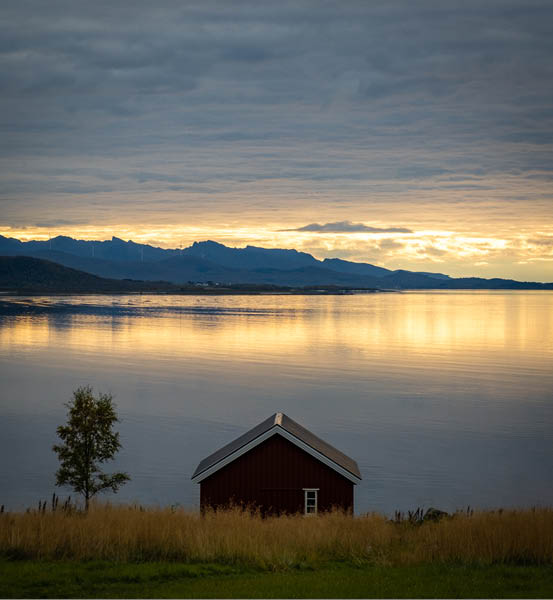
Lofoten Islands Norway
Text and photosNicolas Bertin
Boat hut at sunset near Sortland
After travelling to Yellowstone and Colorado back in 2018, I hadn't done any big trips outside France. I had one trip to the French and Italian Alps in 2019, then another one in the French Alps in 2020 due to COVID restrictions. In 2021 we had the opportunity to travel properly again. I could see some friends from Sweden, so I decided to add a solo trip to the Lofoten Islands and Lappland before that. The itinerary would start in Luleå via Stockholm. Then I would rent a car, see a bit of Sweden, spend about two weeks in the Lofoten islands, and go back to Luleå. This was in September.


14 | Bushwalk August 2022
Lakes near Jokkmokk

A bad start, Jokkmokk and Muddus
The first part of the journey wasn't easy: Scandinavian Airlines was a nightmare. My initial flight plan was Paris-Goteborg-Luleå. They first changed Goteborg for Stockholm, and then the day before it was cancelled at 10 pm. They added a layover to Copenhagen instead. Then my third flight to Luleå from Stockholm was cancelled: they couldn't shut the doors upon boarding the plane. This meant I landed in Luleå at 11 pm. Luckily the hotel I was staying at was open late. But the rest of the trip would be pretty smooth.
The first real travelling part brought me to Jokkmokk, a small town with everything you need, nearby some national parks. Something to be said for Sweden and Norway compared to my last trip in 2015: there's now 4G absolutely everywhere, even on the most remote of roads (this is Lappland). The only way you can escape it is by hiking deep. So navigation is super easy. September in Lappland means it's already autumn: yellowing leaves (which would be fully orange by the end of the trip), cool when not freezing temperatures in the morning. It also means very few tourists. Since there are lakes everywhere, I first went for a bit of photography.
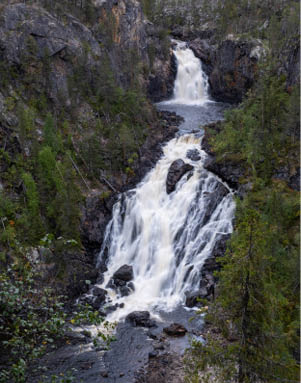
Muddusfallet in Muddus National Park


Hike near Kvikkjokk
15
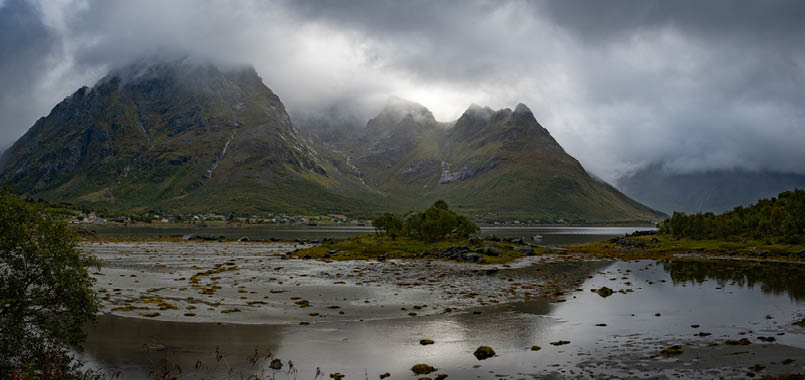
My first actual hike was in Muddus National Park towards big waterfalls. Hiking in Swedish forests is very relaxing, but you seldom get good views until you are at the waterfalls themselves. The great views were on the next day, near Kvikkjokk and the mountains of Sarek National Park, some of the highest mountains in Sweden (1900-2100 metres). Since I had to cope with the rain (this region is very wet), I only went for a short half-day hike. But it was still gorgeous. 360 degree views and a real arctic landscape. The silence was deafening, as there aren't many animals up there.
NorwayAfter three days in Sweden, it was time to enter Norway. There was a check for my vaccine pass at a roadblock a few kilometres after the border, but that was expected. As usual, Norway was stunning. Every road is so scenic you want to stop all the time. I first stopped near a town called Evenskjer. It wasn't the Lofoten islands yet, but the landscape was similar: gigantic cliffs, lakes everywhere, and mountains that rise above the sea level to around 1200 metres. At first, I was worried about all the rain, but the weather kept changing all the time. I had never seen
View of Møysalen national park from the road
so many rainbows in my life. I explored a lake nearby, but it was too wet and fogged in. I didn't bring high shoes, so I got soaked pretty quickly. But the next day, I found an astonishing hike towards the top of some awe-inspiring cliffs North of Kasfjord. I learnt that there are tons of little hikes like this. You simply climb up 100 to 300 metres and get stunning views of other islands, the Norwegian Sea, and fishing villages. The ominous bad weather made it all the more impressive.
It was now time to drive to the Lofoten Islands themselves, to a stunning AirBnB that I had rented right by a fjord. Prices for AirBnB weren't too high, not as high as I remembered them. You could rent a house with a stunning view for about 80 € (A$120) per night. The eye-watering cost would be the fuel though: 2 € (A$3) per litre, that stings, especially when Hertz gives you a massive Volvo SUV instead of a small economical car. But it was truly worth it: the roads are some of the most scenic I've ever seen. Green
16 | Bushwalk August 2022

mountains with cascading waterfalls that seem prehistoric. Fishing villages are hugging a wind-battered coast as if they'd been here for millennia. Towering mountains a quarter the size of those in European Alps, but just as impressive because all of their height is right there, as the roads are at sea level. But I was especially stunned by all the tunnels and bridges that connect these islands. It is so easy to travel here, in this seemingly hostile landscape.
I was lucky to see it in September though. One of the Airbnb owners told me July-August is completely clogged up and unpleasant. But here, apart from some bustling viewpoint car parks in the most touristy areas like Reine, I was free to go where I wanted, not thinking about getting up early to have a spot at a car park. Remember to take cash at the start of the most famous hikes: the car parks are almost always 5 or 10 €, and you need cash. You can only pay online with a Norwegian bank account, but I'm guessing this will change in the next few years.
All the fishing villages are stunning: Reine, Hamnøy, Å. There are small hikes towards viewpoints everywhere, but you can decide to drive and enjoy the views. There are few enough roads that you can drive all the B roads and enjoy yourselves. There are many hidden gems on those roads. And again, the light was changing all the time. I had blue
skies, battering storms, rainbows, fog, drizzle, everything but snow. And due to the warming effects of the Gulf Stream, this is a much more pleasant climate than Sweden.
Many of you may already know the famous view of this fishing village of the Lofoten, Hamnøy. However, if you look for it while you're there like I did, you most likely won't find it. It is actually a view from a one-way concrete bridge. This famous picture leads you to believe the fishing huts face the battering waves of the ocean: they don't. They face a tranquil inlet and that concrete bridge. The road behind the huts isn't really pretty, and you also need the perfect angle so that you don't get some ugly white huts or a car park in the frame. This is the type of location I'm not very fond of. If you look at the picture taken at sunrise, it is beautiful though. But the way it makes you feel isn't how you will feel when you're there. There are many more stunning places in the Lofoten than this. And you will see many photographers simply waiting on that bridge for the perfect light. I can't imagine the competition in summer on that spot.
Rainbow near Tjeldsund Bridge
"
Green mountains with cascading waterfalls that seem prehistoric.


17
That day I decided to take my first actual hike of the trip. I walked about five hours towards the island's centre, not that much elevation gain (I think about 600-700 metres), but really deep in those mountains. Hiking books warn about the mud, and rightly so. It is extremely muddy. Bogs are everywhere, and signage is sometimes fairly poor. Those used to Tasmania will think it's a piece of cake, but it wasn't with my low cut hiking shoes. There are also quite a few sections with chains to help you climb slick rocks, and in the wet, those sections feel a bit uneasy. But the views towards the sea are gorgeous. The lakes are gorgeous, the waterfalls are gorgeous ...
These being islands, there are great white sand beaches too, and some people even surf here. When you go back to your Airbnb in the evening, you're in awe of that gorgeous golden hour that seems to last for so long in the North.
A must-stop in the Lofoten is the perfectly preserved fishing village of Nusfjord. You need to pay a steep 10 € (A$15) to visit it in July and August, but it was free in September, with no crowds. You can take a trip in a fishing boat or simply explore the village and the surrounding walks. Again, I recommend taking all the side roads and exploring those
Hike up Munkebu hut, near Sørvågen
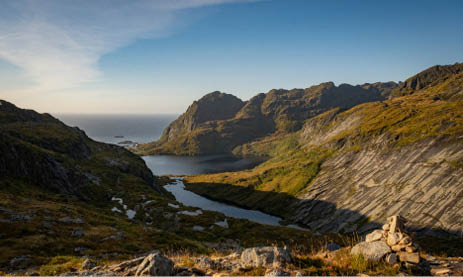
Nappskaret viewpoint
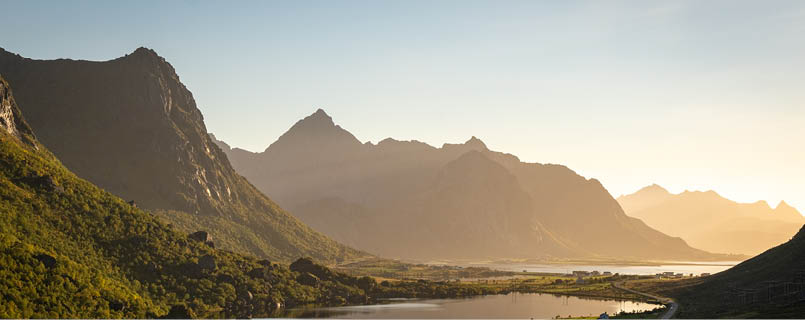

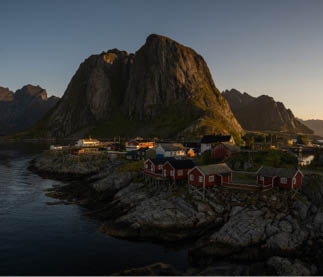
Famous fishing huts in Hamnøy

18 | Bushwalk August 2022
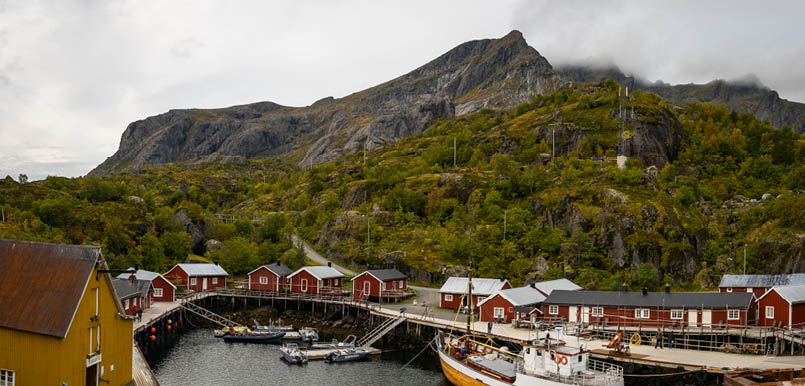
tiny villages. You may find a secret beach, a lovely lighthouse. I was also stunned by the wooden churches or the lawn cemeteries you see here and there. It's a perfect landscape for contemplation, although, with that weather, it usually must be done from a café or the inside of your car. We shall also talk about food: although you will find nice restaurants, cooking at home is more budget-friendly. That may not be as easy as you'd think. There are very few fruits and veggies here. Finding a
good tomato is nearly impossible, and you pay a premium for bad ones. So expect a lot of frozen food, rice and pasta.
SvolværI then switched to another Airbnb on the island, in the "big" city of Svolvær. Although the islands look small on the map, you cannot simply take one central accommodation and explore the lot. You need at least two different locations, or even three if you want to explore the Vesterålen islands as well as I did. The
View from a mountain pass on Austvågøya
part of the Lofoten near Svolvær seems a bit less spectacular. The islands are more extensive, so it feels a bit less wild. It takes longer to get to hikes, like an hour, but you still find incredible viewpoints after short climbs. I never get tired of those amazing views. It's always steep, but each time worth it.
My last hike in the true Lofoten would be another easy but stunning hike. Blue skies this time and a panoramic view that really stunned me. It was probably then that I realized this is one of the most beautiful trips I had ever done. Even in New Zealand, I didn't get views
like this. At least not such a massive reward for minimal walking. I've visited Southern Norway before, with the fjords and the lakes, but this is even better. And it was far from being over ...
The Vesterålen islands are more extensive and slightly more developed than the Lofoten (bigger towns). But there are places that are just as wild, and I rented a house with another stunning view, with a nice wood stove. There are plenty of these tiny houses to rent, with a lovely homely feel. The mountains on this archipelago felt more prominent, more Alpine.
19
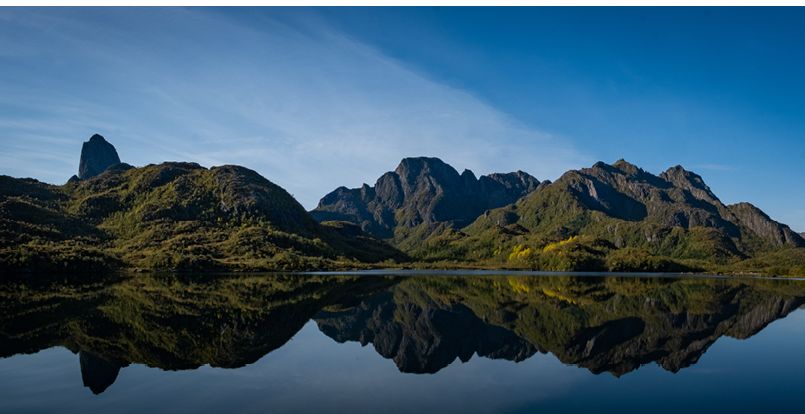
Vesterålen islands
So the views went even further than on the Lofoten; only the cute fishing villages were missing. By that time of the trip, autumn was at its peak too. The forest was mostly orange. It was truly magical, especially on that nice hike towards a round hut.
While the Lofoten were mostly car touring paradise, the Vesterålen were hiking paradise. Plenty of small summits to ascend, with huge rewards. Much less mud than in the Lofoten, which was a big plus. I did a hike on a rocky outcrop surrounded by cliffs, which was both amazing and scary, and then an easy summit that gets you to a true alpine setting. It would have been a shame to skip these islands and only focus on the Lofoten. They are just as spectacular and much, much less crowded. I used the Rother hiking book for the Lofoten, which has hikes for the Vesterålen as well. This book is a must-have if you intend on hiking there. I skipped the scariest and most
difficult hikes because the weather was too unpredictable.
Back to SwedenI then reluctantly drove back to Sweden for the last two days of my trip. I stayed in Kiruna, a mining town for one of the biggest miners in the world. Luckily the town isn't too big, and the area to visit around here, the Abisko National Park, still feels wild. First of all, you can't miss Torneträsk Lake. The road follows the coast of this massive deep blue lake, with a gorgeous mountainous background, with some snow already there in September. You can explore the lake's shores on foot, especially at the mouth of the river Abiskojåkka. Here is also where I saw my first wild reindeer, jumping and eating on the side of the road. It's a very sunny part of Sweden and also the driest, due to the rain shadow provided by the mountain range between Norway and Sweden. Hiking here was nothing but open views and orange trees all around, with a superb backdrop. If you want, you can buy some moose and reindeer meat nearby, and there's a reconstitution of a traditional Saami village (the indigenous people of Lappland).
"
... I realized this is one of the most beautiful trips I had ever done.


20 | Bushwalk August 2022

Nicolas is a physicist working in medical research. He's lived in Melbourne for three years and fell in love with mountain hiking in Tasmania and the High Country. After that, he was lucky to live in Grenoble for a few years, exploring the Alps and developing a passion for landscape photography. Now that he's in Paris, he tries to explore other countries on holidays, and has had the luck to visit some majestic places such as Québec, Utah, Colorado or Scandinavia.
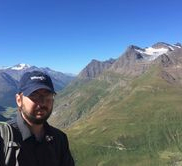
"
Overall it was an amazing and unforgettable trip. Sweden is beautiful, especially around Abisko, but Norway is just too good. I would land directly in the Lofoten if I had to do it again, even though the flights are more expensive. I would also bring high shoes and proper gaiters to do more serious hiking. It's a
must-do for any traveller, but it has to be done in shoulder season. Everyone told me summer was too crowded. I didn't see any auroras, though. I had only one night of clear skies, and they didn't appear that night. To see them, you need clear skies and solar activity, which usually happens in winter.
Road bend on the E10 following the shore of Torneträsk lake

View of Torneträsk lake from Björkliden



21